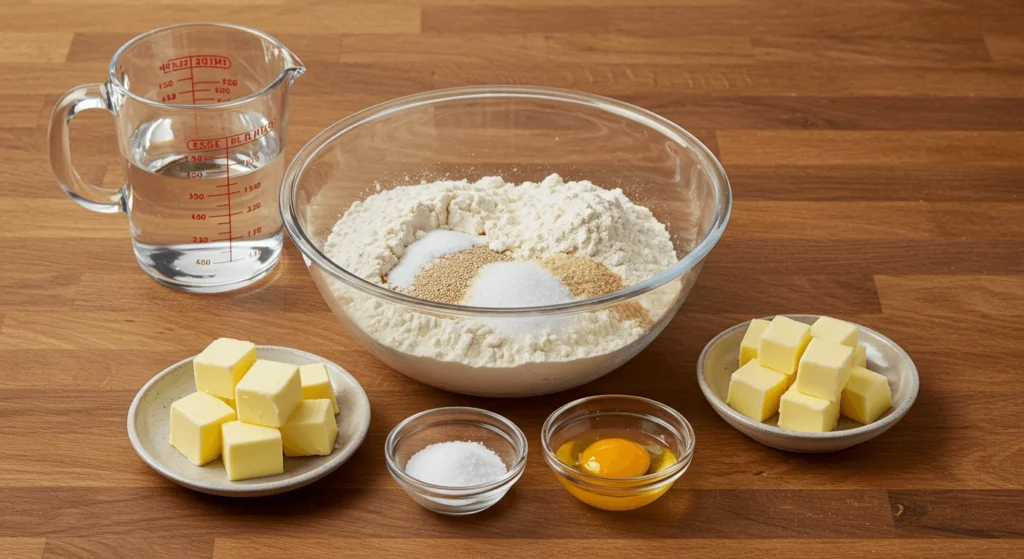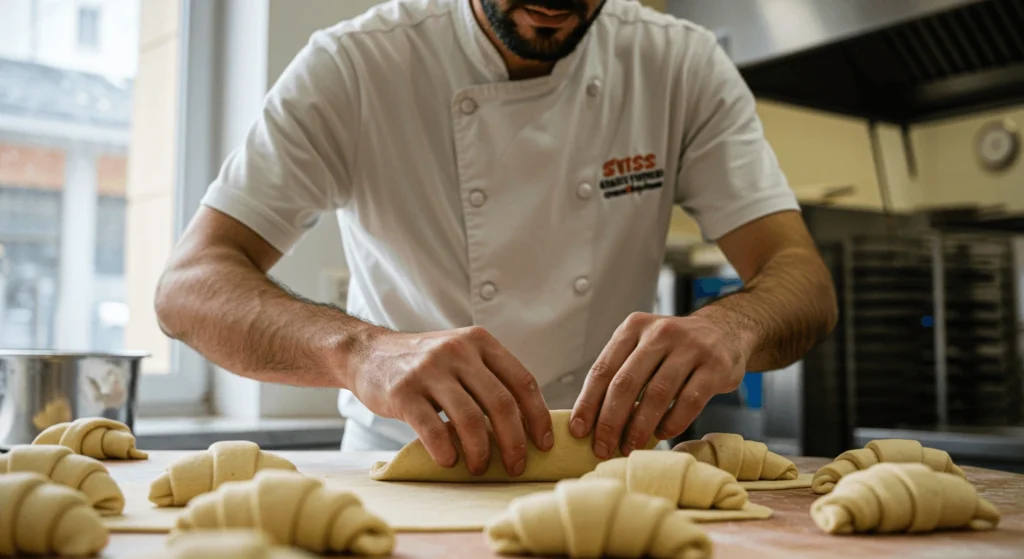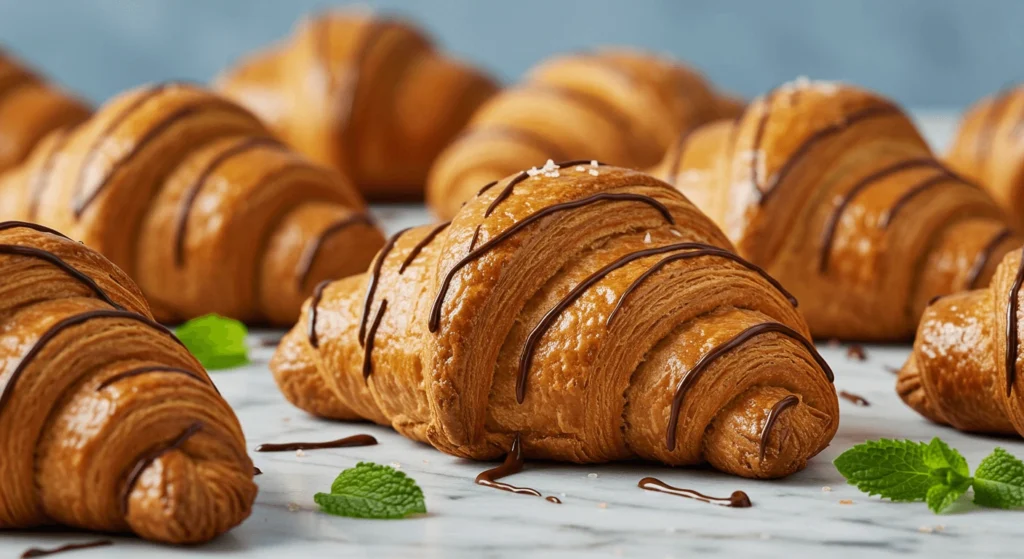Give your kitchen a Swiss twist with this fuss-free recipe of Gipfeli Croissant – the delightful Swiss-style croissant. These buttery, flaky pastries are perfect for breakfast or as a treat with your afternoon coffee.
Table of Contents
Ingredients
- 500g all-purpose flour
- 10g instant yeast
- 50g granulated sugar
- 10g salt
- 300ml cold water
- 200g unsalted butter, chilled and cubed
- Egg wash-1 egg beaten with a splash of water for glazing
Instructions
Step 1: Make the Dough

- Mix Dry Ingredients: In a large bowl, combine flour, instant yeast, sugar, and salt. Make sure that the yeast and salt are on opposite sides of the bowl since salt inhibits the activation of the yeast.
- Add Water: Gradually add the cold water, and mix until a soft dough forms. Knead for 8 to 10 minutes until smooth and elastic.
- Shape and Chill: Shape the dough into a ball, cover it with plastic wrap, and refrigerate for 30 minutes.
Step 2: Prepare the Butter Layer
Make the Butter Block: Place the cubed butter between two sheets of parchment paper.
Using a rolling pin, shape it into a 15cm x 15cm square. Wrap and refrigerate until firm but pliable.
Step 3: Add the Butter
- Roll the Dough: Take the chilled dough out and roll it into a 30cm x 30cm square on a floured surface.
- Place the Butter: Place the block of butter diagonally onto the dough so it forms a diamond shape.
- Fold the corners of the dough over the butter, meeting in the center.
- Pinch the edges to seal the butter inside.
Step 4: Laminate the Dough

First Fold
- Roll the dough out into a rectangle of 20cm x 50cm.
- Fold the bottom one-third up and then the top one-third down over it, in a letter style.
- Wrap the dough and refrigerate for 30 minutes.
Repeat Folds
- Do two more folds of the dough, having it rolled and folded once more, then again, keeping the dough chilled between folds. This is the creation of the flaky layers.
Step 5: Shape the Gipfeli Croissant
Roll Out Dough
- Roll the dough out into a large rectangle about 25cm x 60cm. Trim the edges to give it a good shape.
Cut Triangles
- Using a sharp knife or pizza cutter, slice the dough into long triangles, about 10cm wide at the base.
Shape Croissants
- Starting from the base of each triangle, start rolling tightly into a crescent shape. Place on a parchment-lined baking sheet, tucking the tip of the triangle underneath to hold in place.
Step 6: Proof and Bake
Proofing
- Place the shaped croissants under a clean kitchen towel and let them rise at room temperature for 1-2 hours until they have doubled in size.
Preheat Oven
- Preheat your oven to 375°F (190°C).
Glaze and Bake
- Brush the Gipfeli croissant with the egg wash for that shiny, golden finish. Bake for 18-22 minutes or until puffed and deeply golden brown. Tips for Success
Butter Texture
- Ensure your butter is chilled but pliable to evenly incorporate it into the dough.
Even Layers
- Roll the dough evenly during the laminating process for a consistent, flaky texture.
Avoid Overproofing
- Keep an eye on your croissants during proofing to avoid collapsing. Serve and Enjoy!
Allow the Gipfeli to cool off a bit before serving with jam, honey, or even the buttery, flaky layers say it all. Happy baking!
Storing Your Gipfeli croissant
Should you have some Gipfeli croissant left or wish to make them ahead of time, the proper way of storing them will play a huge role in maintaining their freshness and texture.
- Room Temperature: Place the fully baked and cooled Gipfeli croissant in an airtight container at room temperature for up to 2 days. Reheat them in a preheated 300°F (150°C) oven for 5-7 minutes to refresh their crispiness.
- Freezing: For longer storage, place the unbaked, shaped Gipfeli croissant on a baking sheet and freeze solid. Transfer them to a freezer-safe bag or container for up to 3 months. To bake, let thaw to room temperature and proof before egg washing and baking.
You can enjoy these delicious pastries at any time if you store them properly.
Variations and Flavor Twists

If you want to add some creativity to the classic Gipfeli croissant recipe, here are some delicious variations you can make to customize your croissants.
- Chocolate-Filled Gipfeli croissant: Place a small piece of high-quality dark or milk chocolate at the base of each triangle before rolling it into a crescent shape. The chocolate will melt as the croissants bake, creating a heavenly treat.
- Almond Gipfeli: Brush the tops of Gipfeli croissant with egg wash after they have been shaped and sprinkle sliced almonds over. After baking, the nutty sweet treat will be drizzled with a powdered sugar glaze.
- Savory Gipfeli: Omit the sugar in the dough, adding to taste a pinch of thyme or rosemary. Before rolling the triangles, you may add grated cheese, ham, or very thin slices of vegetables for a savory version that could be just perfect for lunch or snacks.
- Fruit-Filled Gipfeli: Spread a thin layer of fruit jam, such as apricot or raspberry, over each triangle before rolling. The jam adds a tart sweetness to the buttery pastry.
By experimenting with these variations, you can easily tailor the Gipfeli croissant recipe for any occasion, be it sweet or savory. Enjoy the versatility and creativity this classic recipe affords!
Frequently Asked Questions
- Can I use active dry yeast instead of instant yeast?
You can substitute instant yeast for active dry yeast, but you must activate the active dry yeast first: mix in lukewarm water around 100°F/37°C with a pinch of sugar until it becomes frothy after about 5 to 10 minutes. Continue with your recipe, taking care that water measurements must be adjusted by accounting for the liquid used in proving yeast.
- Why is My Dough Tearing During the Laminating Process?
If the dough is tearing while rolling and folding, it’s either too warm or the butter has hardened unevenly. Place the dough back in the refrigerator for 15-20 minutes to allow it to chill before continuing. Make sure your rolling surface is lightly floured so the dough does not stick; however, use too little flour, to avoid drying out the dough.
- Can I make Gipfeli croissant with gluten-free flour?
Well, you can, but working with gluten-free flour is always somewhat tricky since gluten creates the structure. Get a gluten-free croissant or pastry dough recipe to help you guide through, or experiment with gluten-free flour blends that already contain xanthan gum or other binding agents.
- How do I know if my Gipfeli croissant is fully proofed?
A well-proofed Gipfeli croissant will have doubled in size and feel just a little bit jiggly and soft to the touch. You should be able to press into the dough gently, and the indentation will spring back slowly. Be careful not to overproof, as this can make the butter melt out during baking.
- Can I double the recipe?
Of course, you can if you are making Gipfeli croissant in bulk. Just be sure to have enough space on your counter for rolling and folding the dough, and refrigerate one portion while you work on the other to maintain the proper temperature of the dough.
- What if I don’t have a rolling pin?
You can also use a clean glass bottle or any other cylindrical object if you don’t have a rolling pin. Just make sure it’s sturdy enough and has a smooth, even surface.
These are some of the most common questions and problems that arise while making Gipfeli croissant and will help in achieving the perfect flaky croissant every time!
Serving Suggestions for Gipfeli croissant

Gipfeli croissant are versatile pastries that go well with different accompaniments, making them suitable for any time of day. Here are some serving suggestions to elevate your experience:
- Breakfast Delight: Serve your Gipfeli croissant warm with a side of fresh fruit, yogurt, and a steaming cup of coffee or tea. For an indulgent touch, spread on some homemade fruit preserves or a dollop of whipped cream.
- Brunch Board: Arrange different sweet and savory variations of Gipfeli on one platter, with cheeses, smoked salmon, or scrambled eggs for a grand brunch board.
- Afternoon Snack: A glass of cold milk or creamy latte provides a great contrast to the standard afternoon Gipfeli. Add some fresh berries as a garnish or dip in honey for sweetness in your snack.
- Dessert Option: Dust your chocolate-filled or almond Gipfeli with powdered sugar and serve on a plate with a scoop of vanilla ice cream or drizzled with warm caramel sauce.
- Party Platter: Mini Gipfeli in various flavors are great as bite-sized treats for parties. They’re the perfect finger food for entertaining, easy to grab and enjoy.
Whether served as a simple snack or the centerpiece for an elaborate meal, these Gipfeli are sure to impress with their delicate layers and rich flavors. Sharing Your Creations Baking is often best shared, and this will be true of your Gipfeli creations, too. Sharing pastries with friends, family, and online communities lets others appreciate your craft.
- Tasting Night: Invite friends over to taste different flavors of Gipfeli and vote for their favorite. It’s fun, interactive, and a great way to share your work while gathering feedback.
- Gift Them: Put some freshly baked Gipfeli in a nicely decorated box or basket as a nice homemade gift. Attach a note with heating instructions and pairing suggestions.
- Share Online: Snap a photo of your perfectly baked Gipfeli and share it on social media or food blogging platforms. Use hashtags like #Gipfeli or #HomeBaking to connect with other enthusiasts and inspire future bakers.
The fun of baking lies in the making and the sharing, so spread the warmth and joy of these flaky, golden pastries!
Storing and Reheating Gipfeli
Proper storage and reheating methods ensure that your Gipfeli croissant remains as delicious as the moment they came out of the oven. Here are some tips to keep them fresh and flavorful:
- Room Temperature Storage: If you plan to consume your Gipfeli within one or two days, store them at room temperature in an airtight container or tightly wrapped in plastic wrap.
This prevents them from drying out while maintaining their flaky texture.
- Longer storage by freezing: Freeze the Gipfeli croissant for longer storage. Place them on a baking sheet in one layer until frozen solid, then transfer to a freezer-safe bag or container.
This way, they will not stick together and also hold their shape. Frozen Gipfeli can be kept for up to three months.
- Reheating Suggestions: To reheat Gipfeli, put them in a preheated oven at 350°F (175°C) for 5 to 10 minutes to regain their freshly baked crispiness. Do not use the microwave because it may make the pastry soggy and will ruin the fragile layers. When reheating frozen Gipfeli, let them come to room temperature first and then proceed with the oven instructions.
Following these few tips on storage and reheating will get you enjoying your Gipfeli like it’s freshly baked, even days from baking!
Regional Variations

While Gipfeli is most famously associated with Swiss baking traditions, one can find various forms of the croissant in different cultural variations around the world, each with its twists on techniques and flavors.
- Croissants (France): Probably the most famous relation to Gipfeli, French croissants also use similar laminated dough but are usually larger and more buttery for an ultra-rich taste.
- Kifli (Hungary): These pastries, often much sweeter than Gipfeli, are a Hungarian specialty. They may be filled with poppy seeds, nuts, or fruit preserves.
- Rogaliki (Poland): Typically smaller and slightly denser, these Polish crescent rolls are often coated in powdered sugar or icing and enjoyed as a dessert.
- Rogalach (Jewish Communities): A close variation features a rolled dough filled with chocolate, cinnamon, or fruit preserves, offering a delicious bite-sized treat.
Exploring these regional variations can offer inspiration for trying new filling ideas or techniques to further customize your Gipfeli creations!
- Gipfeli Baking Issues: Troubleshooting Tips Even experienced bakers have challenges that pop up sometimes in the process of making Gipfeli. Here are common issues and how you could troubleshoot to get it perfect every time:
- Dry or Tough Dough: If the dough feels dry or tough, it may have been overworked or lacked sufficient moisture. Use cold water sparingly to adjust the consistency while kneading and avoid overhandling to maintain a soft, pliable texture.
- Poor Layering: If your Gipfeli doesn’t show good, flaky layering, then the butter wasn’t correctly incorporated during the lamination process, or the dough was too warm.
Always use cold butter and keep the workspace and tools cool. Also, a good idea is to let the dough rest in the refrigerator between folds.
- Leaking Butter During Baking: this can be due to either the pieces of butter being too thick or folding the dough wasn’t done right and the edges weren’t closed. Roll the dough gently and evenly, making sure the edges are sealed to avoid leaks.
- Underproofed Gipfeli: If your pastry didn’t rise properly and came out dense, it had insufficient proof. Rest the shaped Gipfeli in a warm draft-free spot until they’ve doubled in size before baking.
- Uneven Baking: Inconsistent oven temperature can result in uneven browning or undercooked interiors. Use an oven thermometer to ensure the correct temperature; also, rotate your baking sheet halfway through for even heat distribution.
Meeting these challenges and perfecting your method will get you a flaky, golden utterly delicious batch of Gipfeli every time. It is all about learning to bake, and the little things you do will make all the difference.

